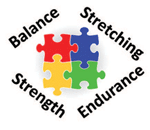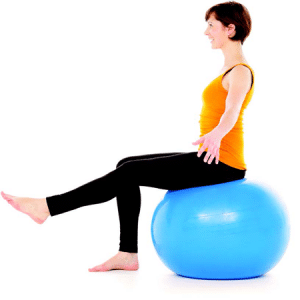To exercise or NOT to exercise?
If you have received conflicting advice about the role of exercise in CMT, you are not alone! Not a CMT clinic day goes by without my being asked:
- – “Will exercise help me get stronger?”
- – “Can exercise hurt people with CMT?”
- – “What types of exercise are best for me?”
- – “How much and how often should I exercise?”

Sabrina Paganoni is a
member of the CMTA
Advisory Board and is
an Assistant Professor at Harvard Medical School.
With this premise in mind, and drawing from what we know about exercise in the general population, let’s sketch a framework for exercise for people with CMT. We are not focusing on only one muscle or area of the body. We are looking at the person as a whole with the goal of making gains in mobility, independence and overall well-being.
Several medical societies have declared that “Exercise is medicine.” But if exercise is a medication, one needs to get the right type and dose. One would not use the same dose of a medication in an adult and a child, or for people who have different symptoms. Likewise, the exercise program and its methods and objectives must be tailored to each individual based on the type of CMT and several other clinical factors.
 Exercise for CMT revolves around four modalities: balance, stretching, endurance and strength. Each modality can be considered a piece of a larger puzzle and needs to be combined with the other modalities for optimal results. Expert guidance from a physical therapist who has experience with CMT is invaluable and should be considered before engaging in any exercise program.
Exercise for CMT revolves around four modalities: balance, stretching, endurance and strength. Each modality can be considered a piece of a larger puzzle and needs to be combined with the other modalities for optimal results. Expert guidance from a physical therapist who has experience with CMT is invaluable and should be considered before engaging in any exercise program.
1. BALANCE
Balance problems are nearly universal with CMT. While this problem cannot be easily solved and assistive devices may still be needed, several simple balance exercises exist and can be performed at home. A chair may be used for support. Tai-chi and modified chair yoga have been shown to help with balance in other diseases.
2. STRETCHING
Stretching exercises help prevent pain and loss of range of motion at joints affected by CMT, such as the ankles. Stretching the heel cords should be a daily routine for people with CMT.
3. ENDURANCE (AEROBIC) EXERCISE
Endurance (aerobic) exercise refers to activities that utilize large muscle groups such as walking, cycling and swimming. This type of exercise helps maintain cardiovascular fitness and has been shown to have several positive health effects in the general population, including improved mood and sleep. Swimming, or aqua therapy, is a great way to get some aerobic exercise as it does not subject the joints to undue stress. Nordic walking poles are a good way to enhance the exercise that you get while walking and they help improve posture at the same time. A stationary recumbent bike is also a great way to get aerobic exercise, especially when the weather prevents outdoor activities. Portable mini-cycles can be used by people in wheelchairs to exercise the arms and/or the legs. You should aim to practice aerobic exercise two to five times per week.
4. STRENGTH TRAINING
You cannot build up muscles that are heavily affected by CMT-induced neurogenic atrophy because the nerve-muscle connection is not working well there. Still, you can strengthen those muscles that are not affected by CMT-induced neurogenic atrophy. Some muscles may become weak simply because they are not being used enough and become “deconditioned.” It is those muscles that we want to strengthen by doing gentle toning exercises two to three times a week. The goal is to use those muscles to help compensate for CMT-related weakness. The core and hip girdle muscles are areas that can be targeted for gentle toning in most people with CMT. Heavyweight, high-intensity training should be avoided and there should be no pain during or after performing these exercises.
*Sman, A. D., Hackett, D., Fiatarone Singh, M., Fornusek, C., Menezes, M. P. and Burns, J. (2015), Systematic review of exercise for Charcot-Marie-Tooth disease. Journal of the Peripheral Nervous System, 20: 347–362.
A Plan to Become More Active
Start low, go slow(especially if you have not exercised recently). But aim high! The aim is to make exercise a fun component of your daily routine. If exercise is something you look forward to, you will keep doing it. Keep it fun! One suggested sequence for getting started is:
1. Pick one balance exercise and a couple of stretching exercises for the lower body. All you need is five minutes a day, maybe while listening to your favorite song or to the news. This will soon become your favorite part of your daily routine.
 2. Add moderate-intensity aerobic training two to five times a week (swimming, walking with Nordic poles, stationary bicycle) and a few core and hip girdle gentle toning exercise two to three times a week. The latter can be done standing, in the chair or in bed.
2. Add moderate-intensity aerobic training two to five times a week (swimming, walking with Nordic poles, stationary bicycle) and a few core and hip girdle gentle toning exercise two to three times a week. The latter can be done standing, in the chair or in bed.
The exact length and type of exercise may vary. (Some people may be able to exercise for five to 10 minutes at a time, while others can do an entire 30 to 45 minute session.) But there should be no muscle pain and no excessive fatigue after the exercises. The idea is to gain without the pain. Muscle pain and excessive post-exercise fatigue (meaning that you need to rest for 30 minutes or more after exercise before resuming your normal activities) are clinical indicators of over-exertion, something to avoid in neuromuscular disease.
If you are looking for more ideas, you are only a click away! The CMTA is committed to empowering people with CMT by providing up-to-date educational material. Please refer to the CMTA website (https://www.cmtausa.org/living-with-cmt/managing-cmt/exercise) for additional articles, tips, and videos on exercise prepared by other members of the Advisory Board. The CMTA exercise videos are a great starting point and allow for modifications depending on the type of CMT. They provide a practical guide on how to perform balance, gentle strengthening and stretching exercises.






